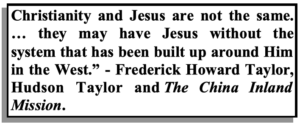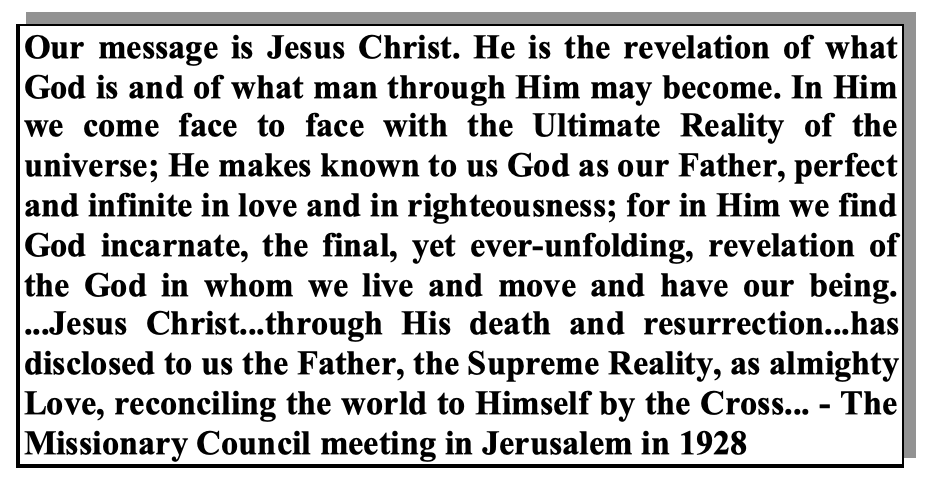A metaphor is a thing regarded as representative or symbolic of something thought unrelated, a comparison between two ideas as if these were synonyms, We use them in sharing the Gospel:
“That was the true Light, which lights every man that comes into the world” [John 1:9].
Paul did not call Jesus our redeemer but our redemption [1 Corinthians 1:30] . He was the ransom price to free us from sin? But will these metaphorical or picturesque representations of our Lord’s crucifixion be misunderstood as gibberish among a peoples or tribal culture, for whom the words, themselves, have no immediate significance?
 When Jesus declared, “Very truly I tell you, unless you eat the flesh of the Son of Man and drink his blood, you have no life in you” [John 6:53] John witnessed “On hearing it, many … said, “This is a hard teaching. Who can accept it?”
When Jesus declared, “Very truly I tell you, unless you eat the flesh of the Son of Man and drink his blood, you have no life in you” [John 6:53] John witnessed “On hearing it, many … said, “This is a hard teaching. Who can accept it?”
“Western interpretations of the atonement,“ Philip Jenkins wrote in The Next Christendom, “ …can be traced to the writings of Saint Anselm around 1100. For Anselm, human sins were like grievous offenses committed against a great Lord, debts that required a ransom or restitution of great price, which, in Christianity took the form of the death of God’s Son. … The biblical Lord became a feudal lord” [Page 7].
Eastern Orthodoxy saw this interpretation for Jesus’ crucifixion as “overly legalistic.” To this we add that the word “atonement” itself was brought into English by William Tyndall centuries later. The concept of “debt” was replaced by John Calvin and the Reformation with talk of criminality, punishment, and God’s wrath.
 Religious training has given us a degree of comfort with the Biblical system of sacri- fices as representative (a type of) Jesus’ death, but to what extent should we consider this metaphor as explicatory in other cultures? How useful is it in a given cultural setting to evangelize a people?
Religious training has given us a degree of comfort with the Biblical system of sacri- fices as representative (a type of) Jesus’ death, but to what extent should we consider this metaphor as explicatory in other cultures? How useful is it in a given cultural setting to evangelize a people?
- “Behold the Lamb of God which taketh away the sin of the world” [John 1:29].
- “[Jesus], after he had offered one sacrifice for sins for ever, sat down on the right hand of God” [Hebrews 10:12].
Catholic missionary, Vincent Donovan, asked in “Christianity Rediscovered” [page 21] “Just what was the essential message of Christianity?” He explained, “With Africans the purpose of words is not to establish logical truth, but to set up social relationships” [Page 22]. He went on to assert that “their culture is all encompassing and all important” [Page 23].
Philip Jenkins in his work, “The Next Christendom” said, which I take as a caution against confusing, diluting, or otherwise compromising the message of our Lord’s Crucifixion,
“Gradually Catholic clergy (as missionaries to Latin American in the 1700’s) succeeded in adapting the liturgy and sacraments to the native worldview and its customs, in a highly successful act of enculturation“ [Page 38].
Enculturation! Catholicism endeavored to inculcate the moral and spiritual message of the Cross as part of the cultural identity of Latin Americans but may have only succeeded in providing a modified religious ritual acceptable to both the Aztecs and Rome. How real was Calvary’s impact on their “faith”?
And how much should this truth impact the very culture it transcends? Don Richardson presented Christ to the Sawi people of the Netherland New Guinea [now: part of Indonesia] God’s “peace child” after their use of the term within their culture.
So how do we introduced to them salvation, grace, holiness, God’s love, in order that they might make these representative of their lifestyle and, in turn, promote the message without losing its emphasis, its inspiration, the “power of the Gospel”? After all, this is, indeed, the task before us!
For I am not ashamed of the gospel, because it is the power of God that brings salvation to everyone who believes: first to the Jew, then to the Africans, Indians, Nepalese, Indonesians, Argentinians, … Romans 1:16.


